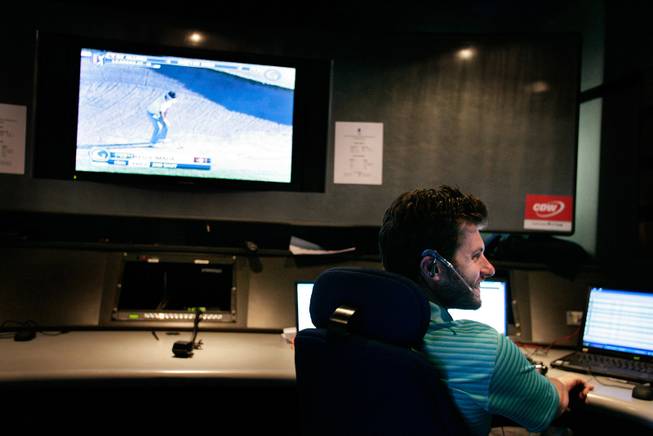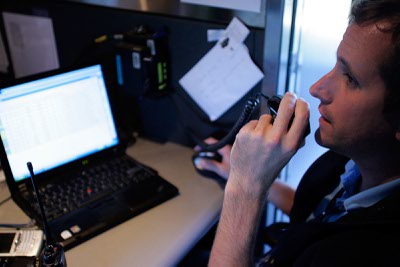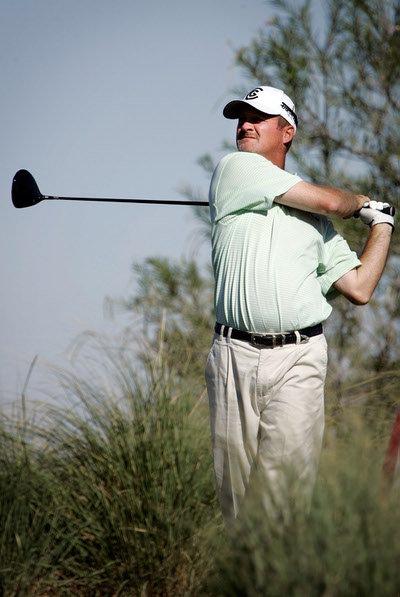
Graham Sevigny, a ShotLink producer, captures and validates scoring data for distribution during the Justin Timberlake Shriners Hospitals for Children Open at TPC Summerlin on Friday, October 17, 2008. ShotLink releases the scoring data to the internet, media centers, hospitality tents, television stations and scoreboards on the course.
Saturday, Oct. 18, 2008 | 1:30 p.m.
Special section
Today's Tee Times
Beyond the Sun
Nearly as amazing as the golfers have been in the opening rounds of the PGA Tour’s Justin Timberlake Shriners Hospitals for Children Open at TPC Summerlin, has been the technology and volunteers covering their every shot.
In the eight years since Sean Howland took a job with the PGA Tour as manger of tournament operations, the way he has covered the sport has changed completely.
“My entire job, from the day I took it until now, is a completely different world,” Howland said. “We used to have one truck, the scoreboards rode in the back, and we had an eight by six control room built into the front. Four of us sat in there and we did everything.”
Rest assured that Shotlink, the official name of the technology side of the PGA Tour, has more trucks now. They have a full size trailer as an operating room, and they train somewhere around 350 local volunteers to help out at each tournament.
“It used to be a very rudimentary system, very basic,” Howland said. “Now it’s pretty unbelievable.”
With the goal of enhancing the viewers’ experience, Shotlink has taken what used to be a hole-by-hole system that included tear off sheets and simple stats, into a shot-by-shot, real time analysis of every player at every hole.
“We live in a world today that is much more based on interactivity than it used to be,” said Mark Gambill, vice president of CDW Corporation, a technology company that works with the Tour. “As a viewer at an event you want to be engaged somehow, and we believe technology is at the core of that.”
The system is set up so that each group on the course is accompanied by a volunteer who enters shot times into a WiFi controller that relays information to the Shotlink trailer. Lasers are set up in the fairways and greens to monitor ball placement and swing analysis.
“We have a habit of taking equipment traditionally used for a very different purpose and using it in a way where the manufacturers are like, ‘Whoa,’” Howland said. “We have a laser company in Atlanta that makes lasers for police that help them catch you speeding, we went to them and ordered all this equipment and they didn’t know why.”
Results from Shotlink are shown at each Tour event on eleven scoreboards, providing live results and player and course information. The connection zips instantaneous stats to television stations and media Web sites, as well as synching up visual ball paths straight to fans’ handheld devices at select tournaments. TOURCast, an online interactive application on PGATOUR.com, won an Emmy in 2005 in part because of Shotlink’s technology.
“The things they do are fantastic,” said PGA Tour pro Jerry Kelly. “With the handhelds they’ve had at some of the majors, I really can’t think of what else you’d need. Even when you’re following one person, you can keep up with others. You can be following [Fred] Couples, and be like ‘Oh, hey, Kelly just hit it in the water.’”
Some players, like Kelly, have taken the technology even further. At a tournament in Los Angeles, Kelly’s swing coach couldn’t be there in person. The two set up a laptop on the driving range and communicated through a live video feed.
“We just took the Macbook Pro out there, set up IChat on the range,” said Kelly, who missed the cut of 6-under 138 to advance to this weekend’s rounds. “As long as you’re on WiFi, there you have it. He’s sitting there watching me going, ‘Kelly, what the hell are you doing?’”
As far as the future of PGA Tour technology is concerned, Howland said it’s anyone’s guess. But judging by his first eight years, things certainly won’t stay the same.
“We don’t know what’s coming next because there’s no telling what technology’s bringing,” Howland said. “But since we’ve been doing this, we’ve never gotten a ‘Hey, this is great, let’s keep doing this. Nice job guys, take a break.’ There’s always something new being planned.”



Join the Discussion:
Check this out for a full explanation of our conversion to the LiveFyre commenting system and instructions on how to sign up for an account.
Full comments policy